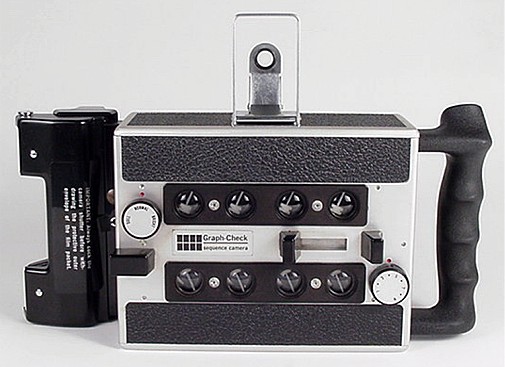
Graph-Check Sequence Camera

The Graph-Check Sequence camera is not only unusual looking, its design was unique enough to be awarded a U.S. patent in 1965. This special-purpose camera produces eight images on a 4 x 5 inch print. Each image is formed by a separate lens and shutter. The shutters do not fire simultaneously, but in sequence, allowing the camera to capture eight moments in time of a moving subject.
The photographer can adjust the interval of time between successive exposures by turning the right knob on the camera front (looking at the camera front). This knob is numbered from 1 to 9 These settings correspond to a total sequence duration of from 4 seconds to 1/10 second. By setting this control below the number 1, the total duration is extended to approximately 10 seconds.
Shutter speed is fixed at 1/1000 second on the model 300 and 1/250 second on the model 400 camera. Aperture is adjustable by turning the knob on the left camera front. This control has settings for Dull, Normal and Bright lighting conditions.
The lenses have a 50mm focal length. Focus is not adjustable, but depth of field is large, extending from 3 1/2 feet to infinity.
The viewfinder is a very simple folding wire frame design, and yet this is completely adequate for the type of use the camera is put to.
The camera's designer intended the Graph-Check to be simple for anyone to use. Earlier cameras designed for sequence photography were very technical, less flexible, did not provide instant processing and were sold to very small and specialized markets. The Graph-Check is truly easy to use and in my opinion a perfect execution of the designer's stated goals. Design and manufacturing were first-rate. The two cameras in my collection still function perfectly.
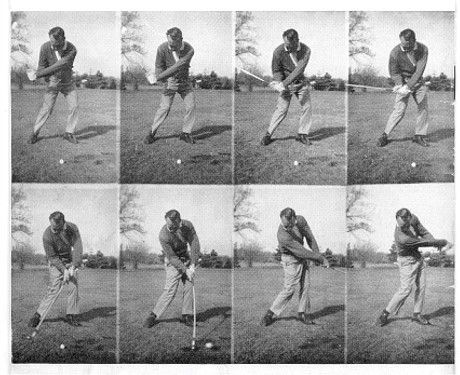
This sample photograph from the camera instruction manual highlights what was probably the most common application of the Graph-Check Sequence camera - analysis of a golfer's swing. Each of the eight photographs measures 1 1/8 x 1 3/4 inches. The individual images are large enough to see the salient details of a sportsman's movements. Even after the Graph-Check was no longer manufactured, until Polaroid pulled their fim off the market Graph-Check cameras were still being used to analyze golf swing. They have also been used to study movement in a variety of athletic activities including those of divers and gymnasts.
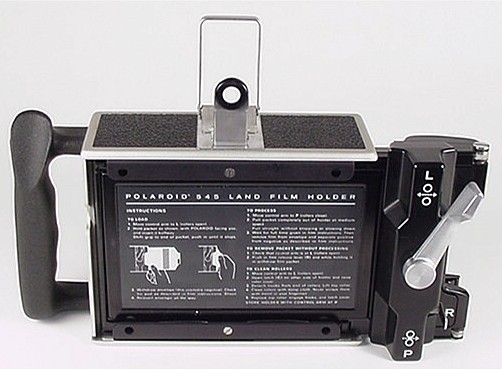
The Graph-Check camera was designed and manufactured by Photogrammetry Inc. of Rockville, Maryland. The camera was sold by Graph-Check Inc. of St. Petersburg, Florida. The camera's film holder was made by Polaroid Corp. of Cambridge, Massachusetts. This example is equipped with a Polaroid model 545 film holder. Earlier Graph-Check cameras were sold with the earlier Polaroid model 500 film holder.
I believe the Graph-Check camera was introduced in 1963. I am not certain when it was discontinued. A 1975 professional photographic equipment catalog lists the Graph-Check model 400 for sale at $450.00.
To be an effective teaching aid for athletes, the camera designer believed that an instant film system was vital. By packaging standard Polaroid film holders with its camera Photogrammetry could concentrate on the engineering and manufacturing details required of a novel sequence camera design and free itself from the enormous expense and risk of developing an instant film system. I doubt a project this ambitious was ever contemplated.
Polaroid 4 x 5 inch film holders were popular accessories for large-format cameras. The holder was designed to slide into a camera back in place of a standard sheet-film holder.
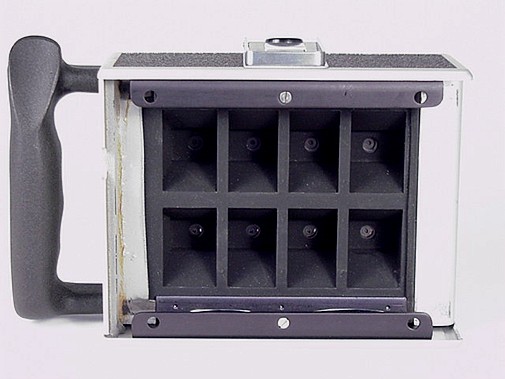
With the Polaroid film holder removed from the camera, the individual lenses and film chambers can be seen.
The camera body is made of cast aluminum. The camera may appear large, but for one capable of accepting 4 x 5 inch film, it is relatively compact. With the holder mounted, and including the handgrip, the overall dimensions are 11 inches wide by 5 1/2 inches tall by 4 1/2 inches deep. The camera weighs 4 3/4 pounds, but is easy to hold thanks to the great handgrip.
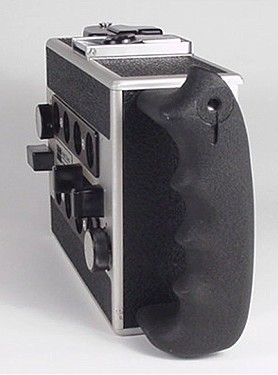
The Graph-Check Sequence camera was available in two models, the model 300 and 400. The model 300 was designed for use outdoors while the model 400 was intended for indoor use in dimmer lighting conditions.
There are four differences between the two models and only two differences are visible. On the model 400 the camera handgrip was tapped with a threaded hole to allow mounting of a Sylvania Sun Gun II for indoor artificial light. The model 300 handgrip does not have this mounting hole. The other visible difference is the model number is engraved on the maker's nameplate. The differences that are not noticeable are the model 400 has a slower shutter speed of 1/250 second vs. 1/1000 for the model 300, and the model 400 has aperture settings of f/11, f/19 and f/32, while model 300 has settings of f/16, f/26 and f/45.
The model 400 could be used both indoors and out. The faster shutter speed of the model 300 made it impractical for indoor use. However, for fast action, the model 300 shutter speed of 1/1000 second was preferable.
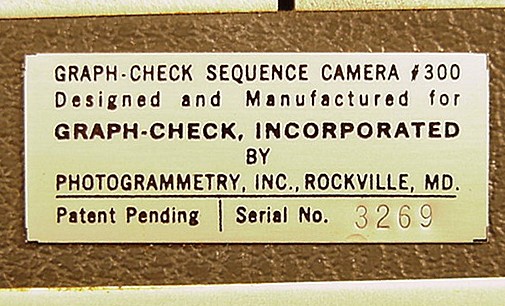
The model 300 was designed for outdoor use with high-speed Polaroid type 57 film. Type 57 film had an ASA rating of 3,200.

The model 400 was designed for indoor use, but could be used outdoors as well. Polaroid type 57 film was to be used when shooting indoors. When shooting outdoors, Graph-Check recommended using type 52 film which was rated at 400 ASA, in bright sunlight with the aperture control set to Dull.
It would be possible to shoot sheet film in standard film holders with either model if instant processing is not needed. However, Graph-Check did not promote this approach. ISO 400 4 x 5 inch sheet film is available, and would be just right for the model 400 outdoors. This film can be push-processed as high as ISO 3200 for use in either model.
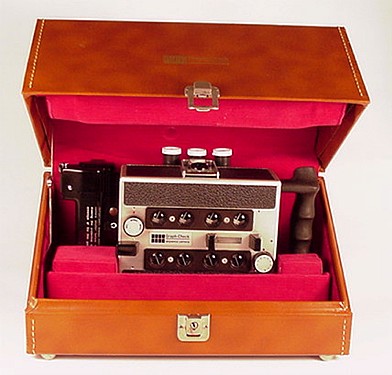
The Graph-Check carrying case was included with the purchase of the camera. The case has storage compartments for packages of Polaroid film and containers of print coater.

|
Page created June 3, 2002;
updated December 20, 2020 |